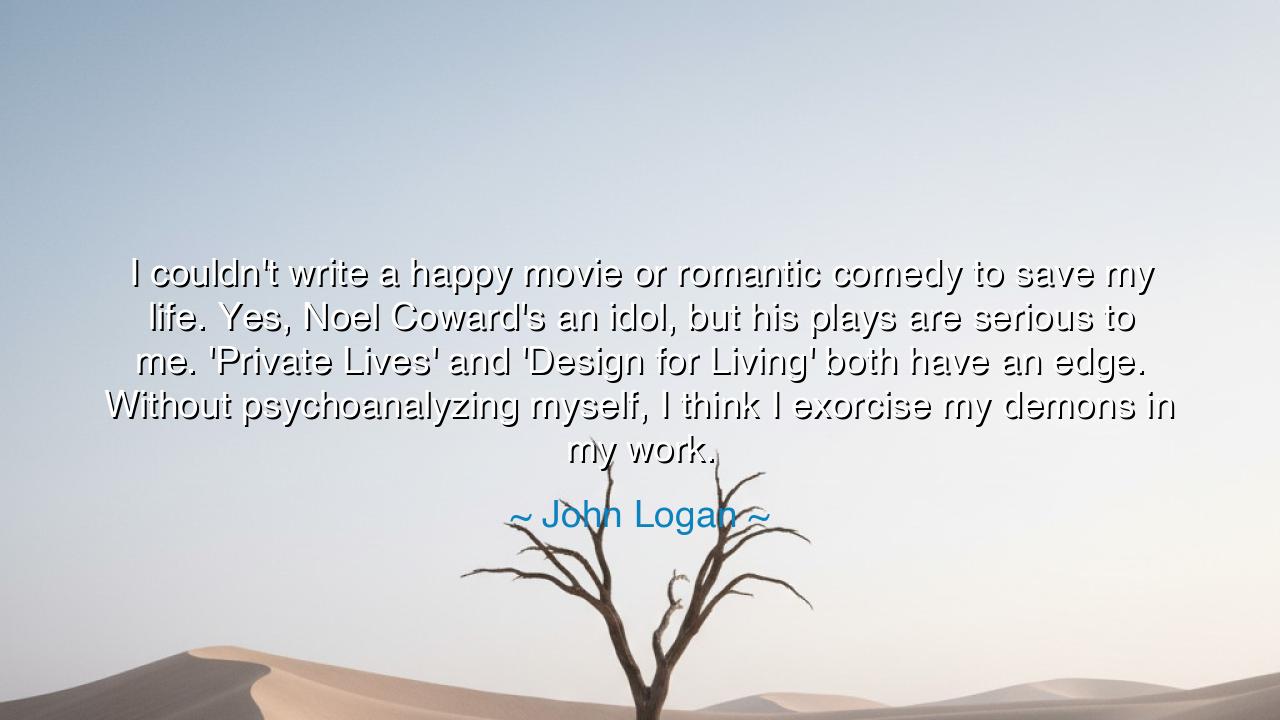
I couldn't write a happy movie or romantic comedy to save my
I couldn't write a happy movie or romantic comedy to save my life. Yes, Noel Coward's an idol, but his plays are serious to me. 'Private Lives' and 'Design for Living' both have an edge. Without psychoanalyzing myself, I think I exorcise my demons in my work.






In the haunting and honest words of John Logan, the confession — “I couldn’t write a happy movie or romantic comedy to save my life. Yes, Noel Coward’s an idol, but his plays are serious to me. ‘Private Lives’ and ‘Design for Living’ both have an edge. Without psychoanalyzing myself, I think I exorcise my demons in my work.” — carries within it the essence of the artist’s ancient struggle: the transformation of pain into creation. Here speaks not merely a screenwriter, but a man who understands that art is both wound and healing, both darkness and illumination. His words echo the timeless truth that what an artist creates is often not an act of leisure, but an act of survival — the sacred alchemy of turning suffering into something that endures.
The meaning of this quote lies in the recognition that true art rarely springs from ease or comfort. Logan confesses that he cannot write stories of lightness or romance, not because he despises them, but because his soul is drawn toward the deeper waters — toward themes of struggle, identity, and redemption. The cheerful worlds of romantic comedy demand a kind of serenity that his heart cannot find; his pen, instead, bleeds honesty. To him, even the wit of Noel Coward, a writer renowned for his sophistication and humor, conceals seriousness and sorrow beneath its brilliance. For Logan, as for many great artists, creation is not escapism — it is exorcism, a way to confront the demons that dwell within the human psyche.
The origin of such words comes from a lifetime of writing characters who stand at the edge of shadow — men and women caught between power and despair, truth and illusion. Logan, the author behind works such as Gladiator, The Aviator, and Penny Dreadful, writes not to entertain but to explore. His stories pulse with psychological intensity, not because he seeks darkness for its own sake, but because he understands that the human soul is forged there. When he says he “exorcises his demons,” he reveals the secret of the artist’s craft — that through art, one gives shape to inner chaos, freeing oneself and others by expressing what cannot be spoken in ordinary life. This act, ancient as storytelling itself, is both confession and cure.
The ancients understood this sacred duty well. The philosopher Aristotle, in his reflections on tragedy, wrote that art serves the purpose of catharsis — the cleansing of the emotions through pity and fear. The great dramatists of Greece — Aeschylus, Sophocles, Euripides — did not write to amuse; they wrote to heal the collective soul of their people. Their plays were rituals of truth, confronting death, fate, and the folly of man. So too does John Logan, in his modern craft, carry on this lineage. When he writes of gladiators, vampires, or haunted minds, he is not inventing monsters — he is revealing them. He is showing that within every human heart lies a battlefield between light and shadow.
This act of exorcising demons through creation is not reserved for writers alone. Every soul, in its own way, must face its inner chaos. Some do it through words, others through music, labor, prayer, or silence. To confront one’s demons is not to dwell in despair, but to wrestle with truth until it yields beauty. The sculptor Michelangelo once said that the statue already existed within the marble — his task was only to carve away the excess stone. Likewise, Logan’s confession teaches that our demons, when confronted, can be carved into art, wisdom, and compassion. They do not disappear; they are transformed.
There is a profound humility in Logan’s words — a refusal to romanticize suffering, even as he admits its creative power. He does not claim to control his pain; instead, he channels it, disciplines it, and offers it as story. This is the mark of maturity in an artist and in any human being — not to be consumed by one’s emotions, but to make them serve a purpose. The edge he speaks of, that tension between beauty and brutality, is the mark of all lasting art. For without the shadow, light has no meaning; without pain, joy is shallow. It is in this balance that truth resides.
Let this be the lesson to all who labor in the arts, or in the craft of living itself: do not flee your darkness — refine it. Whatever haunts you can become the source of your greatest creation, if only you face it with courage and honesty. Write your pain into poetry; build your heartbreak into bridges of understanding. Do not seek to imitate others’ joy — find your own truth, even if it trembles. For only by confronting the tempest within can one bring calm to the world without.
And so, dear listener, remember the wisdom of John Logan: “I exorcise my demons in my work.” When your heart grows heavy with doubt or grief, turn not to denial, but to creation. Let your labor, whatever its form, become the fire in which your burdens are burned and reborn as light. For those who learn to make beauty from pain do not merely survive — they become alchemists of the soul, transforming the lead of suffering into the gold of meaning.






AAdministratorAdministrator
Welcome, honored guests. Please leave a comment, we will respond soon